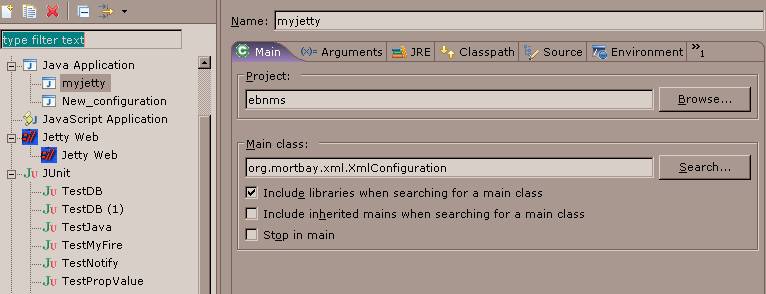- 浏览: 442515 次
- 性别:

- 来自: 北京
-

社区版块
- 我的资讯 ( 0)
- 我的论坛 ( 29)
- 我的问答 ( 0)
存档分类
- 2012-12 ( 1)
- 2012-10 ( 1)
- 2012-09 ( 1)
- 更多存档...
最新评论
-
king_qingÔºö
xinzhi_3600 ÂÜôÈÅìu013275927 ÂÜôÈÅì§ßÂì•Ôºå‰ΩÝ ...
注解@PostConstruct与@PreDestroy -
superLinuxÔºö
可以了,按照3楼的修改下就可以了
Eclipse is running in a JRE, but a JDK is required 解决方法 -
whg333Ôºö
zy315351965 ÂÜôÈÅìËØ∑‰ΩÝÈ™åËØʼnª•ÂêéÂÜçÂèëÂá∫Êù•Ôºå‰∏ç˶Åʵ™Ë¥πÂÆùË¥µ ...
Eclipse is running in a JRE, but a JDK is required 解决方法 -
zy315351965Ôºö
ËØ∑‰ΩÝÈ™åËØʼnª•ÂêéÂÜçÂèëÂá∫Êù•Ôºå‰∏ç˶Åʵ™Ë¥πÂÆùË¥µÁöÑÊó∂Èó¥
Eclipse is running in a JRE, but a JDK is required 解决方法 -
xinzhi_3600Ôºö
u013275927 ÂÜôÈÅì§ßÂì•Ôºå‰ΩÝËøôÈîôËØØÊålj∫܉∏âÂπ¥ÔºåÂæóÂΩ±Âìç§öÂ∞ë‰∫∫ ...
注解@PostConstruct与@PreDestroy
目前发现的最好最快的直接在ECLIPSE中JETTY调试方式
- 博客分类:
- APP SERVER









相关推荐
在Eclipse这个强大的Java开发环境中,配置Jetty服务器来调试Web项目是一项常用的任务。Jetty是一个轻量级、高性能的开源HTTP服务器和Servlet容器,它允许开发者在本地环境快速部署和测试Web应用。本文将详细介绍如何...
为了在Eclipse中方便地调试和运行基于Jetty的Web应用,可以安装Jetty For Eclipse插件。这个压缩包"Jetty For Eclipse 插件快速安装.rar"包含了必要的文件,帮助用户快捷地在Eclipse环境中集成Jetty。 1. **插件...
Run-Jetty-RunÊò؉∏ÄʨæÂú®EclipseÈõÜÊàêºÄÂèëÁéØ¢ɉ∏≠Á∫é‰æøÊç∑ÈÉ®ÁΩ≤ÂíåË∞ÉËØïJettyÊúçÂä°Âô®ÁöÑÊè퉪∂„ÄÇËøô‰∏™Á¶ªÁ∫øÂÆâË£ÖÂåÖÊèê‰æõ‰∫܉∏ÄÁßçÊóÝÈúÄËÅîÁΩëÂ∞±ËÉΩ‰∏∫EclipseÊ∑ªÂäÝJettyÊîØÊåÅÁöÑÊñπÊ≥ïÔºåÂ∞§ÂÖ∂ÈÄÇÁ∫éÈÇ£‰∫õÁΩëÁªúÁéØ¢ɉ∏çÁ®≥ÂÆöÊàñËÄÖÈúÄ˶ÅÂú®ÈöîÁ¶ªÁéØ¢ÉÂ∑•‰ΩúÁöÑ...
Jetty调试插件是专为Eclipse开发的一款实用工具,旨在简化Web应用程序的部署和调试过程。Jetty是一个轻量级、高性能的Java Web服务器和Servlet容器,它提供了对HTTP协议的支持,允许开发者在本地环境快速搭建服务器...
8. **ËøêË°åÂíåË∞ÉËØï**ÔºöÂú®Eclipse‰∏≠ËøêË°åMavenÁöÑjetty:runÁõÆÊÝáÔºåÂêØÂä®JettyÊúçÂä°Âô®ÔºåÁÑ∂ÂêéÂú®ÊµèËßàÂô®‰∏≠ËÆøÈóÆÂ∫îÁÄÇÂÄüÂä©JRebelԺ剪£ÁÝÅÊõ¥Êîπ‰ºöÁ´ãÂç≥ÂèçÊòÝÂú®ËøêË°åÁöÑÂ∫îÁ∏≠ÔºåÊóÝÈúÄÊâãÂä®Âà∑Êñ∞ÊàñÈáçÂêØ„ÄÇ ÈÄöËøáËøôÊÝ∑ÁöÑÈÖçÁΩÆÔºåºÄÂèëËÄÖÂè؉ª•Âú®Eclipse...
对于初学者来说,了解如何在Eclipse中集成Maven和Jetty进行开发是非常重要的一步。本文将详细介绍这一过程,并提供一些基本的命令用法。 ##### 2.1 Maven2集成Eclipse在线安装 1. **打开Eclipse**: - 启动...
ÈùôÊÄÅÈÉ®ÁΩ≤ÊòØÊåáÁõ¥Êé•Â∞ÜWebÂ∫îÁî®ÈÉ®ÁΩ≤Âà∞JettyÁöÑ`webapps`ÁõÆÂΩï‰∏ãÔºåJetty‰ºöÂú®ÂêØÂä®Êó∂Ëá™Âä®Êâ´ÊèèËØ•ÁõÆÂΩïÂπ∂ÂäÝËΩΩWebÂ∫îÁÄÇ **5.3 Âä®ÊÄÅÁÉ≠ÈÉ®ÁΩ≤** Èô§‰∫ÜÈùôÊÄÅÈÉ®ÁΩ≤§ñÔºåJettyËøòÊîØÊåÅÂä®ÊÄÅÁÉ≠ÈÉ®ÁΩ≤ÔºåÂç≥Âú®‰∏çÈáçÂêØÊúçÂä°Âô®ÁöÑÊÉÖÂܵ‰∏ãÊõ¥Êñ∞WebÂ∫îÁÄÇËøô...
Êú¨ÊñáÂ∞ÜËضÁªÜ‰ªãÁªçÂú®Eclipse‰∏≠Áöщ∏ĉ∫õÂ∏∏Áî®ÈÖçÁΩÆÔºåËøô‰∫õÈÖçÁΩÆÂØπ‰∫éÂàùÂ≠¶ËÄÖÊù•ËØ¥Â∞§ÂÖ∂Èáç˶ÅÔºåËÉΩ§üÊèêÂçáºÄÂèëÊïàÁéáÂíåËàíÈÄÇÂ∫¶„ÄÇ È¶ñÂÖàÔºåEclipseÁöÑÁºñÁÝÅËÆæÁΩÆÊòغÄÂèëËøáÁ®ã‰∏≠ÈùûÂ∏∏ÂÖ≥ÈîÆÁöщ∏ÄÁéØ„ÄÇÂú®`window->preferences->general->Content Types`...
【run-jetty-run】是一款专为Eclipse集成开发环境设计的插件,它极大地简化了在Eclipse中启动和调试Jetty服务器的过程。Jetty是一个轻量级、高性能的Java Web服务器和Servlet容器,广泛应用于各种规模的Web应用。...
Âú®JavaÁéØ¢ɉ∏≠ÔºåÊà뉪¨ÈÄöÂ∏∏‰ΩøÁ∏ªÔºàMainÔºâÊñπÊ≥ïÊù•ÂêØÂä®JettyÊúçÂä°Âô®ÔºåËøôÊÝ∑Âè؉ª•Êñπ‰æøÂú∞Âú®ÂëΩ‰ª§Ë°åÊàñËÄÖÈõÜÊàêºÄÂèëÁéØ¢ɉ∏≠Âø´ÈÄüËøêË°åWebÂ∫îÁÄÇ ÊÝáÈ¢ò"mainÊñπÊ≥ïÂêØÂä®jetty"ÊåáÁöÑÂ∞±ÊòØÈÄöËøáÁºñÂÜô‰∏ĉ∏™ÂåÖÂê´mainÊñπÊ≥ïÁöÑJavaÁ±ªÔºåË∞ÉÁî®JettyÁöÑÁõ∏ÂÖ≥...
在开发环境中使用Jetty时,通常需要配置调试模式、热部署等功能。 #### 十八、安全 **18.1 安全配置** Jetty提供了多种安全机制,如认证、授权等,可以通过配置文件来设置安全策略。 #### 十九、FAQ **19.1 ...
Âú®ÂºÄÂèëÈò∂ÊƵԺå‰ΩøÁî®JettyÂè؉ª•ÂÆûÁé∞Âø´ÈÄüÁöÑËø≠‰ª£ÂíåË∞ÉËØïÔºåÂõ݉∏∫ÂÆÉÂè؉ª•Áõ¥Êé•ËøêË°åÂú®ÂºÄÂèëÁéØ¢ɉ∏≠ÔºåÊóÝÈúÄÈÉ®ÁΩ≤Âà∞‰∏ìÈó®ÁöÑÊúçÂä°Âô®‰∏ä„ÄÇ **Struts2 + Maven + Jetty ÂÆû‰æã** Âú®Java WebappºÄÂèë‰∏≠ÔºåÁªìÂêàStruts2„ÄÅMavenÂíåJettyÔºåÂè؉ª•ÂÆûÁé∞È´òÊïà...
`maven-jetty-plugin`ÂÖÅËÆ∏Âú®MavenÊûѪ∫ËøáÁ®ã‰∏≠Áõ¥Êé•ËøêË°åÂíåÈÉ®ÁΩ≤Â∫îÁÄÇ ### ÊĪÁªì JettyÂÆπÂô®ÂõÝÂÖ∂ËΩªÈáèÁ∫ß„ÄÅÈ´òÊïàÂíåÁŵʥªÁöÑÁâπÊÄßÔºåÂú®Java WebºÄÂèëÈ¢ÜÂüüÂæóÂà∞‰∫ÜÂπøÊ≥õÂ∫îÁÄlj∫ÜËߣÂíåÊéåÊè°JettyÁöщΩøÁî®ÊñπÊ≥ïÂíåÈÖçÁΩÆÊäÄÂ∑ßÔºåÂØπ‰∫éÊèêÂçáºÄÂèëÊïàÁéá...
6. **ÊûѪ∫Â∑•ÂÖ∑**ÔºöMavenÊàñAntÁöÑÈõÜÊàê‰ΩøÂæóÊûѪ∫ÂíåÁÆ°ÁêÜJavaÈ°πÁõÆÂèòÂæóÊõ¥ÂäÝÁÆÄÂçïÔºåÁî®Êà∑Âè؉ª•Áõ¥Êé•Âú®Eclipse‰∏≠ÈÖçÁΩÆÂíåÊâßË°åÊûѪ∫ËøáÁ®ã„ÄÇ 7. **ÊÄßËÉΩ‰ºòÂåñ**ÔºöMars 2ÁâàÊú¨Âú®ÊÄßËÉΩ‰∏äËøõË°å‰∫܉ºòÂåñÔºåÂêØÂä®Êõ¥Âø´ÔºåÂÜÖÂ≠òÂçÝÁî®Êõ¥‰ΩéÔºåÊèêÂçá‰∫ÜÊ雷ΩìºÄÂèë...
„ÄäJettyÊè퉪∂ÂèäÂÖ∂Âú®Eclipse‰∏≠ÁöÑÁÉ≠ÈÉ®ÁΩ≤ÂÆûË∑µ„Äã JettyÊò؉∏ÄʨæËΩªÈáèÁ∫ßÁöÑJava WebÊúçÂä°Âô®ÂíåServletÂÆπÂô®Ôºå‰ª•ÂÖ∂È´òÊïà„ÄÅÂ∞èÂ∑ß„ÄÅÊòìÁî®ËÄåÊ∑±ÂèóºÄÂèëËÄÖÂñúÁౄÄlj∏éTomcatÁõ∏ÊØîÔºåJettyÂêåÊÝ∑ÊîØÊåÅÁÉ≠ÈÉ®ÁΩ≤ÂäüËÉΩÔºåÂÖÅËÆ∏ºÄÂèëËÄÖÂú®‰∏çÈáçÂêØÊúçÂä°Âô®ÁöÑÊÉÖÂܵ‰∏ã...
ÊĪÁöÑÊù•ËØ¥ÔºåJetty RunÊè퉪∂Êèê‰æõ‰∫܉∏ÄÁßç‰æøÊç∑ÁöÑÊñπºèÔºå‰ΩøºÄÂèëËÄÖËÉΩ§üËøÖÈÄüÂêØÂä®ÂíåË∞ÉËØïÂü∫‰∫éJettyÁöÑWebÂ∫îÁî®ÔºåËÄåÊóÝÈúÄÊ∑±ÂÖ•‰∫ÜËߣÊúçÂä°Âô®ÁöѧçÊùÇÈÖçÁΩÆ„ÄÇÈÄöËøá‰∏ãËΩΩÂíå‰ΩøÁî®Ëøô‰∏™Êè퉪∂ÔºåÂè؉ª•ÊûŧßÂú∞ÊèêÈ´òºÄÂèëÊïàÁéáÔºåÁâπÂà´ÊòØÂØπ‰∫éÈ¢ëÁπÅËøõË°åËø≠‰ª£ÂíåʵãËØï...
在下载的压缩包中,"eclipse-inst-win64.exe" 是Eclipse的安装程序。双击运行此文件,将会启动Eclipse的安装向导,引导用户完成安装过程。向导会询问安装路径、选择要安装的组件以及设置Eclipse的默认配置。用户可以...
5. **CDT(C/C++ Development Tooling)增强**:对于C和C++开发者,CDT在Oxygen中进行了性能优化,提供了更快的索引和更强大的调试功能。 6. **PyDev(Python开发插件)改进**:对于Python开发者,PyDev在Eclipse ...
Âú®ÈÉ®ÁΩ≤Âà∞webÊúçÂä°Âô®ÁöÑËøáÁ®ã‰∏≠ÔºåEclipseÁöÑJava EEÈÄèËßÜÂõæÔºàJava EE PerspectiveÔºâÊèê‰æõ‰∫ÜÈõÜÊàêÁöÑÊúçÂä°Âô®ËßÜÂõæÔºàServer ViewÔºâÔºåÂè؉ª•Ê∑ªÂäÝÂíåÁÆ°ÁêÜÂêÑÁßçwebÊúçÂä°Âô®Ôºå¶ÇTomcat„ÄÅJettyÁ≠â„ÄǺÄÂèëËÄÖÂè؉ª•Áõ¥Êé•Âú®EclipseÂÜÖÂêØÂ䮄ÄÅÂÅúÊ≠¢ÊúçÂä°Âô®...
同时,Eclipse支持多种应用服务器的连接,如Tomcat、Jetty等,方便进行应用的部署和调试。 对于插件扩展,Eclipse的一大优势就是其丰富的插件生态系统。书中会介绍如何查找、安装和使用各种插件,以满足不同开发...